Urban Expansion and Farmland Loss in Beijing during 1980–2015
Abstract
1. Introduction
2. Materials and Methods
2.1. Study Area and Data Sources
2.2. Analysis of the Rates and Patterns of Urban Land Expansion and Farmland Loss
2.2.1. Rate and Intensity of Urban Expansion and Farmland Loss
2.2.2. Spatial Patterns of Urban Expansion and Farmland Loss
2.3. Evaluation of the Farmland Lost by Urban Expansion
2.3.1. Quantity Assessment
2.3.2. Quality Evaluation
3. Results
3.1. Urban Expansion in Beijing during 1980–2015
3.2. Farmland Loss in Beijing during 1980–2015
3.3. Dependence and Contribution of Urban Expansion on Farmland Loss
3.4. Quality of the Farmland Lost by Urban Expansion
4. Discussion
4.1. Urban Expansion and Farmland Loss
4.2. Comparison with National Level and Relevant Studies
4.3. Policy Implications
5. Conclusions
Author Contributions
Funding
Conflicts of Interest
References
- UN. World Urbanization Prospects:The 2014 Revision; Department of Economic and Social Affairs, Ed.; UN: New York, NY, USA, 2015. [Google Scholar]
- Normile, D. China’s living laboratory in urbanization. Science 2008, 319, 740–743. [Google Scholar] [CrossRef] [PubMed]
- National Bureau of Statistics of China. China Statistical Year Book; China Statistical Press: Beijing, China, 2016.
- World Bank—Development Research Center of the State Council. Urban China: Toward Efficient, Inclusive, and Sustainable Urbanization; World Bank: Washington, DC, USA, 2014; pp. 1–583. [Google Scholar]
- Liu, T.; Liu, H.; Qi, Y. Construction land expansion and cultivated land protection in urbanizing China: Insights from national land surveys, 1996–2006. Habitat Int. 2015, 46, 13–22. [Google Scholar] [CrossRef]
- Long, H.L.; Ge, D.Z.; Zhang, Y.N.; Tu, S.S.; Qu, Y.; Ma, L. Changing man-land interrelations in China’s farming area under urbanization and its implications for food security. J. Environ. Manag. 2018, 209, 440–451. [Google Scholar] [CrossRef] [PubMed]
- Zhao, D.M.; Wu, J. The Influence of Urban Surface Expansion in China on Regional Climate. J. Clim. 2017, 30, 1061–1080. [Google Scholar] [CrossRef]
- Liao, J.B.; Wang, T.J.; Jiang, Z.Q.; Zhuang, B.L.; Xie, M.; Yin, C.Q.; Wang, X.M.; Zhu, J.L.; Fu, Y.; Zhang, Y. WRF/Chem modeling of the impacts of urban expansion on regional climate and air pollutants in Yangtze River Delta, China. Atmos. Environ. 2015, 106, 204–214. [Google Scholar] [CrossRef]
- Cao, Q.; Yu, D.Y.; Georgescu, M.; Wu, J.G.; Wang, W. Impacts of future urban expansion on summer climate and heat-related human health in eastern China. Environ. Int. 2018, 112, 134–146. [Google Scholar] [CrossRef] [PubMed]
- Du, N.R.; Ottens, H.; Sliuzas, R. Spatial impact of urban expansion on surface water bodies—A case study of Wuhan, China. Landsc. Urban Plan. 2010, 94, 175–185. [Google Scholar] [CrossRef]
- Dong, Y.; Liu, Y.; Chen, J.N. Will urban expansion lead to an increase in future water pollution loads?—A preliminary investigation of the Haihe River Basin in northeastern China. Environ. Sci. Pollut. Res. 2014, 21, 7024–7034. [Google Scholar] [CrossRef] [PubMed]
- He, C.Y.; Liu, Z.F.; Tian, J.; Ma, Q. Urban expansion dynamics and natural habitat loss in China: A multiscale landscape perspective. Glob. Chang. Biol. 2014, 20, 2886–2902. [Google Scholar] [CrossRef] [PubMed]
- Lin, T.; Xue, X.Z.; Shi, L.Y.; Gao, L.J. Urban spatial expansion and its impacts on island ecosystem services and landscape pattern: A case study of the island city of Xiamen, Southeast China. Ocean Coast. Manag. 2013, 81, 90–96. [Google Scholar] [CrossRef]
- Zhao, S.Q.; Da, L.J.; Tang, Z.Y.; Fang, H.J.; Song, K.; Fang, J.Y. Ecological consequences of rapid urban expansion: Shanghai, China. Front. Ecol. Environ. 2006, 4, 341–346. [Google Scholar] [CrossRef]
- Xie, W.X.; Huang, Q.X.; He, C.Y.; Zhao, X. Projecting the impacts of urban expansion on simultaneous losses of ecosystem services: A case study in Beijing, China. Ecol. Indic. 2018, 84, 183–193. [Google Scholar] [CrossRef]
- Wang, H.X.; Zhang, M.H.; Cai, Y. Problems, challenges, and strategic options of grain security in China. In Advances in Agronomy; Sparks, D.L., Ed.; Academic Press: Cambridge, MA, USA, 2009; Volume 103, pp. 101–147. [Google Scholar]
- Li, Y.Y.; Li, X.B.; Tan, M.H.; Wang, X.; Xin, L.J. The impact of cultivated land spatial shift on food crop production in China, 1990–2010. Land Degrad. Dev. 2018, 29, 1652–1659. [Google Scholar] [CrossRef]
- Liu, G.L.; Zhang, L.C.; Zhang, Q.; Musyimi, Z. The response of grain production to changes in quantity and quality of cropland in Yangtze River Delta, China. J. Sci. Food Agric. 2015, 95, 480–489. [Google Scholar] [CrossRef] [PubMed]
- Atta-ur-Rahman; Surjan, A.; Parvin, G.A.; Shaw, R. Impact of Urban Expansion on Farmlands: A Silent Disaster; Elsevier Inc.: New York, NY, USA, 2016. [Google Scholar] [CrossRef]
- Liu, F.; Zhang, Z.X.; Shi, L.F.; Zhao, X.L.; Xu, J.Y.; Yi, L.; Liu, B.; Wen, Q.K.; Hu, S.G.; Wang, X.; et al. Urban expansion in China and its spatial-temporal differences over the past four decades. J. Geogr. Sci. 2016, 26, 1477–1496. [Google Scholar] [CrossRef]
- Wei, Y.D.; Ye, X.Y. Urbanization, urban land expansion and environmental change in China. Stoch. Environ. Res. Risk Assess. 2014, 28, 757–765. [Google Scholar] [CrossRef]
- Long, H.; Li, Y.; Liu, Y.; Woods, M.; Zou, J. Accelerated restructuring in rural China fueled by ‘increasing vs. decreasing balance’ land-use policy for dealing with hollowed villages. Land Use Policy 2012, 29, 11–22. [Google Scholar] [CrossRef]
- Kuang, W.; Liu, J.; Dong, J.; Chi, W.; Zhang, C. The rapid and massive urban and industrial land expansions in China between 1990 and 2010: A CLUD-based analysis of their trajectories, patterns, and drivers. Landsc. Urban Plan. 2016, 145, 21–33. [Google Scholar] [CrossRef]
- Xu, X.; Min, X. Quantifying spatiotemporal patterns of urban expansion in China using remote sensing data. Cities 2013, 35, 104–113. [Google Scholar] [CrossRef]
- Yin, J.; Yin, Z.; Zhong, H.; Xu, S.; Hu, X.; Wang, J.; Wu, J. Monitoring urban expansion and land use/land cover changes of Shanghai metropolitan area during the transitional economy (1979–2009) in China. Environ. Monit. Assess. 2011, 177, 609–621. [Google Scholar] [CrossRef] [PubMed]
- Quan, B.; Bai, Y.; Römkens, M.J.M.; Chang, K.-T.; Song, H.; Guo, T.; Lei, S. Urban land expansion in Quanzhou City, China, 1995–2010. Habitat Int. 2015, 48, 131–139. [Google Scholar] [CrossRef]
- Kuang, W.; Chi, W.; Lu, D.; Dou, Y. A comparative analysis of megacity expansions in China and the U.S.: Patterns, rates and driving forces. Landsc. Urban Plan. 2014, 132, 121–135. [Google Scholar] [CrossRef]
- Wu, W.; Zhao, S.; Zhu, C.; Jiang, J. A comparative study of urban expansion in Beijing, Tianjin and Shijiazhuang over the past three decades. Landsc. Urban Plan. 2015, 134, 93–106. [Google Scholar] [CrossRef]
- Chen, J.; Chang, K.-T.; Karacsonyi, D.; Zhang, X. Comparing urban land expansion and its driving factors in Shenzhen and Dongguan, China. Habitat Int. 2014, 43, 61–71. [Google Scholar] [CrossRef]
- Gao, J.; Wei, Y.D.; Chen, W.; Chen, J. Economic transition and urban land expansion in Provincial China. Habitat Int. 2014, 44, 461–473. [Google Scholar] [CrossRef]
- Li, X.; Zhou, W.; Ouyang, Z. Forty years of urban expansion in Beijing: What is the relative importance of physical, socioeconomic, and neighborhood factors? Appl. Geogr. 2013, 38, 1–10. [Google Scholar] [CrossRef]
- Osman, T.; Divigalpitiya, P.; Arima, T. Driving factors of urban sprawl in Giza Governorate of Greater Cairo Metropolitan Region using AHP method. Land Use Policy 2016, 58, 21–31. [Google Scholar] [CrossRef]
- Shu, B.; Zhang, H.; Li, Y.; Qu, Y.; Chen, L. Spatiotemporal variation analysis of driving forces of urban land spatial expansion using logistic regression: A case study of port towns in Taicang City, China. Habitat Int. 2014, 43, 181–190. [Google Scholar] [CrossRef]
- He, C.; Li, J.; Zhang, X.; Liu, Z.; Zhang, D. Will rapid urban expansion in the drylands of northern China continue: A scenario analysis based on the Land Use Scenario Dynamics-urban model and the Shared Socioeconomic Pathways. J. Clean. Prod. 2017, 165, 57–69. [Google Scholar] [CrossRef]
- Li, L.; Sato, Y.; Zhu, H. Simulating spatial urban expansion based on a physical process. Landsc. Urban Plan. 2003, 64, 67–76. [Google Scholar] [CrossRef]
- Kuang, W. Simulating dynamic urban expansion at regional scale in Beijing-Tianjin-Tangshan Metropolitan Area. J. Geogr. Sci. 2011, 21, 317–330. [Google Scholar] [CrossRef]
- Chang, H.S.; Chen, T.L. Exploring spatial patterns of farmland transactions and farmland use changes. Environ. Monit. Assess. 2015, 187, 596. [Google Scholar] [CrossRef] [PubMed]
- Zhong, T.Y.; Huang, X.J.; Zhang, X.Y.; Wang, K. Temporal and spatial variability of agricultural land loss in relation to policy and accessibility in a low hilly region of southeast China. Land Use Policy 2011, 28, 762–769. [Google Scholar] [CrossRef]
- Feng, Q.L.; Gong, J.H.; Liu, J.T.; Li, Y. Monitoring Cropland Dynamics of the Yellow River Delta based on Multi-Temporal Landsat Imagery over 1986 to 2015. Sustainability 2015, 7, 14834–14858. [Google Scholar] [CrossRef]
- Xie, Y.C.; Mei, Y.; Tian, G.J.; Xing, X.R. Socio-econornic driving forces of arable land conversion: A case study of Wuxian City, China. Glob. Environ. Chang. 2005, 15, 238–252. [Google Scholar] [CrossRef]
- Song, J.; Ye, J.T.; Zhu, E.Y.; Deng, J.S.; Wang, K. Analyzing the Impact of Highways Associated with Farmland Loss under Rapid Urbanization. ISPRS Int. J. Geo-Inf. 2016, 5, 94. [Google Scholar] [CrossRef]
- Shi, W.J.; Tao, F.L.; Liu, J.Y. Changes in quantity and quality of cropland and the implications for grain production in the Huang-Huai-Hai Plain of China. Food Secur. 2013, 5, 69–82. [Google Scholar] [CrossRef]
- Yang, H.; Li, X.B. Cultivated land and food supply in China. Land Use Policy 2000, 17, 73–88. [Google Scholar] [CrossRef]
- Zhong, T.Y.; Huang, X.J.; Zhang, X.Y.; Scott, S.; Wang, K. The effects of basic arable land protection planning in Fuyang County, Zhejiang Province, China. Appl. Geogr. 2012, 35, 422–438. [Google Scholar] [CrossRef]
- Liang, C.; Penghui, J.; Wei, C.; Manchun, L.; Liyan, W.; Yuan, G.; Yuzhe, P.; Nan, X.; Yuewei, D.; Qiuhao, H. Farmland protection policies and rapid urbanization in China: A case study for Changzhou City. Land Use Policy 2015, 48, 552–566. [Google Scholar] [CrossRef]
- Shen, X.Q.; Wang, L.P.; Wu, C.F.; Lv, T.G.; Lu, Z.W.; Luo, W.B.; Li, G. Local interests or centralized targets? How China’s local government implements the farmland policy of Requisition-Compensation Balance. Land Use Policy 2017, 67, 716–724. [Google Scholar] [CrossRef]
- Tan, M.H.; Li, X.B.; Xie, H.; Lu, C.H. Urban land expansion and arable land loss in China—A case study of Beijing-Tianjin-Hebei region. Land Use Policy 2005, 22, 187–196. [Google Scholar] [CrossRef]
- Cai, H.Y.; Yang, X.H.; Xu, X.L. Spatiotemporal Patterns of Urban Encroachment on Cropland and Its Impacts on Potential Agricultural Productivity in China. Remote Sens. 2013, 5, 6443–6460. [Google Scholar] [CrossRef]
- Zhang, Z.X.; Wen, Q.K.; Liu, F.; Zhao, X.L.; Liu, B.; Xu, J.Y.; Yi, L.; Hu, S.G.; Wang, X.; Zuo, L.J.; et al. Urban expansion in China and its effect on cultivated land before and after initiating “Reform and Open Policy”. Sci. China-Earth Sci. 2016, 59, 1930–1945. [Google Scholar] [CrossRef]
- Shi, K.F.; Chen, Y.; Yu, B.L.; Xu, T.B.; Li, L.Y.; Huang, C.; Liu, R.; Chen, Z.Q.; Wu, J.P. Urban Expansion and Agricultural Land Loss in China: A Multiscale Perspective. Sustainability 2016, 8, 790. [Google Scholar] [CrossRef]
- Zhang, J.A.; Pu, L.J.; Peng, B.Z.; Gao, Z.G. The impact of urban land expansion on soil quality in rapidly urbanizing regions in China: Kunshan as a case study. Environ. Geochem. Health 2011, 33, 125–135. [Google Scholar] [CrossRef] [PubMed]
- Song, W.; Pijanowski, B.C.; Tayyebi, A. Urban expansion and its consumption of high-quality farmland in Beijing, China. Ecol. Indic. 2015, 54, 60–70. [Google Scholar] [CrossRef]
- Beijing Municipal Bureau of Statistics. Beijing Statistical Year Book; China Statistical Press: Beijing, China, 2016.
- Liu, J.; Zhang, Z.; Xu, X.; Kuang, W.; Zhou, W.; Zhang, S.; Li, R.; Yan, C.; Yu, D.; Wu, S.; et al. Spatial patterns and driving forces of land use change in China during the early 21st century. J. Geogr. Sci. 2010, 20, 483–494. [Google Scholar] [CrossRef]
- Zhang, M.; Huang, X.; Chuai, X.; Yang, H.; Lai, L.; Tan, J. Impact of land use type conversion on carbon storage in terrestrial ecosystems of China: A spatial-temporal perspective. Sci. Rep. 2015, 5, 10233. [Google Scholar] [CrossRef] [PubMed]
- Liu, J.; Kuang, W.; Zhang, Z.; Xu, X.; Qin, Y.; Ning, J.; Zhou, W.; Zhang, S.; Li, R.; Yan, C.; et al. Spatiotemporal characteristics, patterns, and causes of land-use changes in China since the late 1980s. J. Geogr. Sci. 2014, 24, 195–210. [Google Scholar] [CrossRef]
- Ministry of Land and Resources of the People’s Republic of China. Regulation for Gradation on Agriculture Land Quality; GB/T 28407-2012; Standards Press of China: Beijing, China, 2012.
- Liu, Y.; Zhang, Y.; Guo, L. Towards realistic assessment of cultivated land quality in an ecologically fragile environment: A satellite imagery-based approach. Appl. Geogr. 2010, 30, 271–281. [Google Scholar] [CrossRef]
- Liu, X.; Zhao, C.; Song, W. Review of the evolution of cultivated land protection policies in the period following China’s reform and liberalization. Land Use Policy 2017, 67, 660–669. [Google Scholar] [CrossRef]
- Beijing Municipal Bureau of Forestry and Parks (General Office of Capital Greening Commission). Work Summary of the 12th Five-Year Plan, the 13th Five-Year Plan and the 2016 Work Plan. Available online: http://zfxxgk.beijing.gov.cn/110038/jh32/2016-06/02/content_705014.shtml (accessed on 2 June 2016).
- Chen, J.; Gao, J.; Chen, W. Urban land expansion and the transitional mechanisms in Nanjing, China. Habitat Int. 2016, 53, 274–283. [Google Scholar] [CrossRef]
- Peng, W.; Wang, G.; Zhou, J.; Zhao, J.; Yang, C. Studies on the temporal and spatial variations of urban expansion in Chengdu, western China, from 1978 to 2010. Sustain. Cities Soc. 2015, 17, 141–150. [Google Scholar] [CrossRef]
- Pandey, B.; Seto, K.C. Urbanization and agricultural land loss in India: Comparing satellite estimates with census data. J. Environ. Manag. 2015, 148, 53–66. [Google Scholar] [CrossRef] [PubMed]
- Martellozzo, F.; Ramankutty, N.; Hall, R.J.; Price, D.T.; Purdy, B.; Friedl, M.A. Urbanization and the loss of prime farmland: A case study in the Calgary-Edmonton corridor of Alberta. Reg. Environ. Chang. 2015, 15, 881–893. [Google Scholar] [CrossRef]
- Skog, K.L.; Steinnes, M. How do centrality, population growth and urban sprawl impact farmland conversion in Norway? Land Use Policy 2016, 59, 185–196. [Google Scholar] [CrossRef]
- Han, S.S. Urban expansion in contemporary China: What can we learn from a small town? Land Use Policy 2010, 27, 780–787. [Google Scholar] [CrossRef]
- Beijing Municipal Commission of City Planning and Land Resources Management. Beijing City Master Plan (2016–2035). Available online: http://www.bjghw.gov.cn/web/ztgh/ztgh000.html (accessed on 27 September 2017).
- The People’s Government of Beijing Municipality. Disperse the Non-Capital Functions and Promote the Coordinated Development of Beijing, Tianjin and Hebei. Available online: http://zhengwu.beijing.gov.cn/zwzt/sjfsdgn/ (accessed on 4 September 2017).
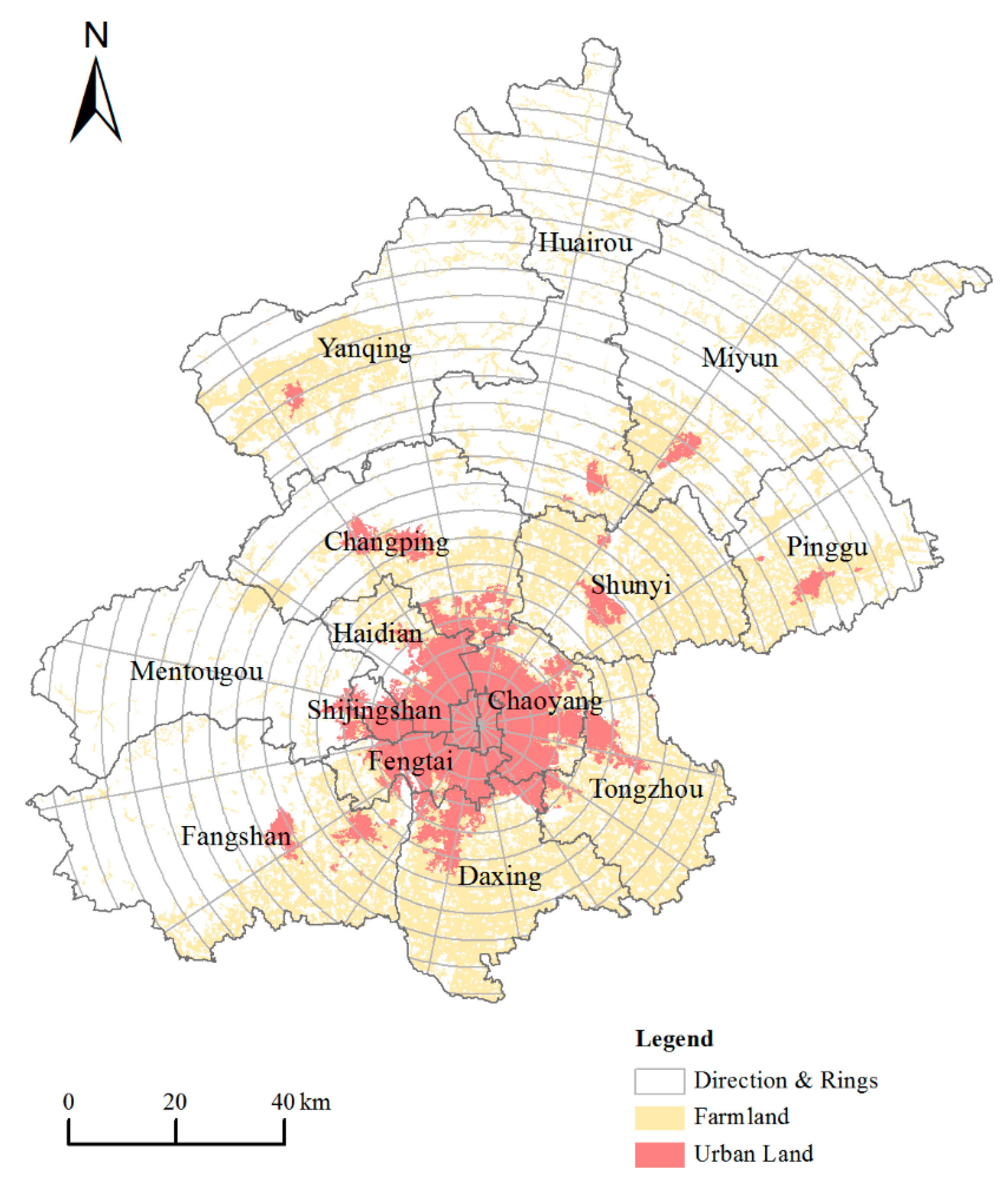
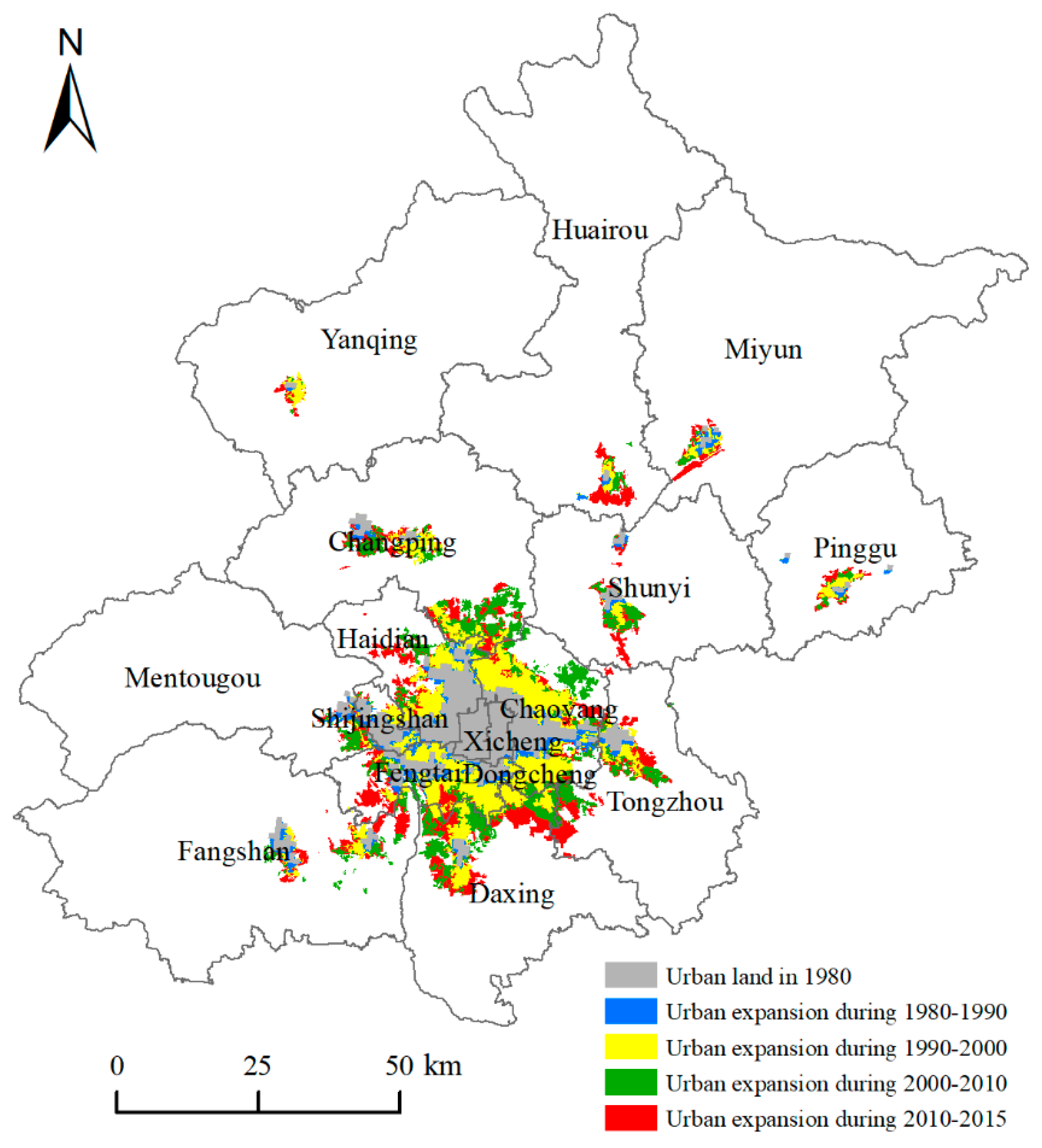
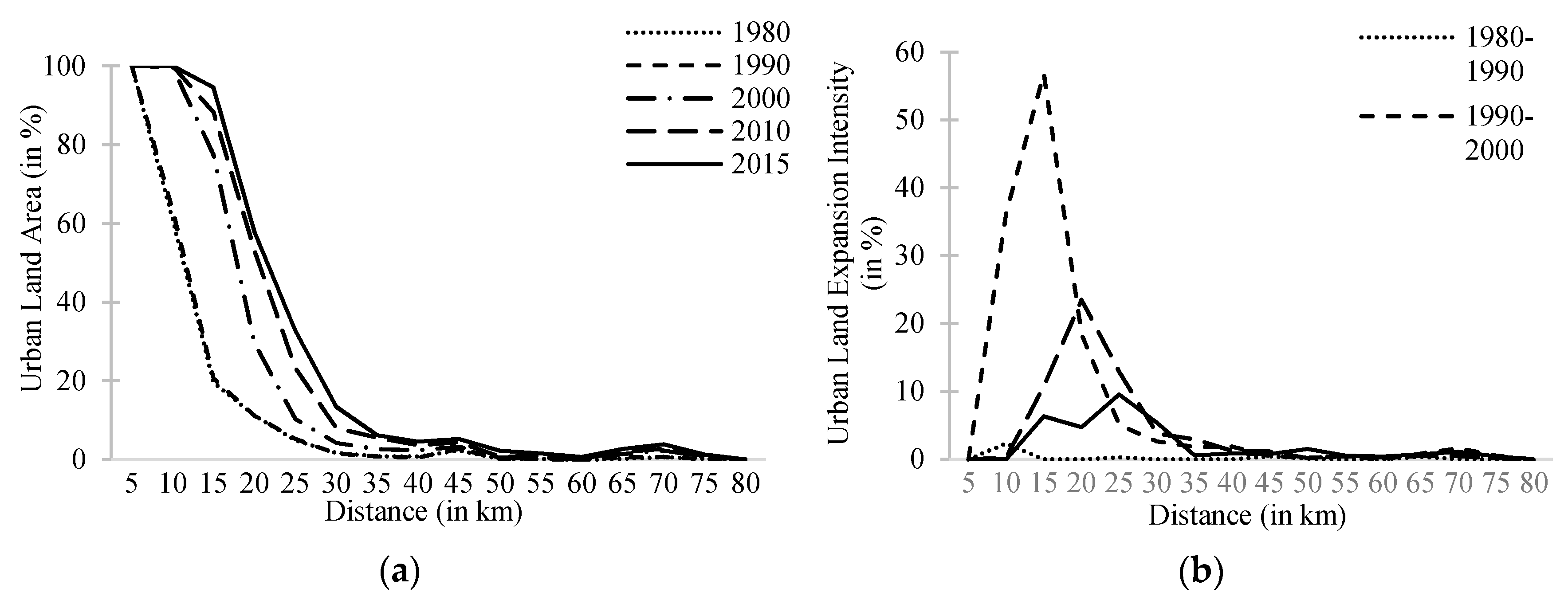
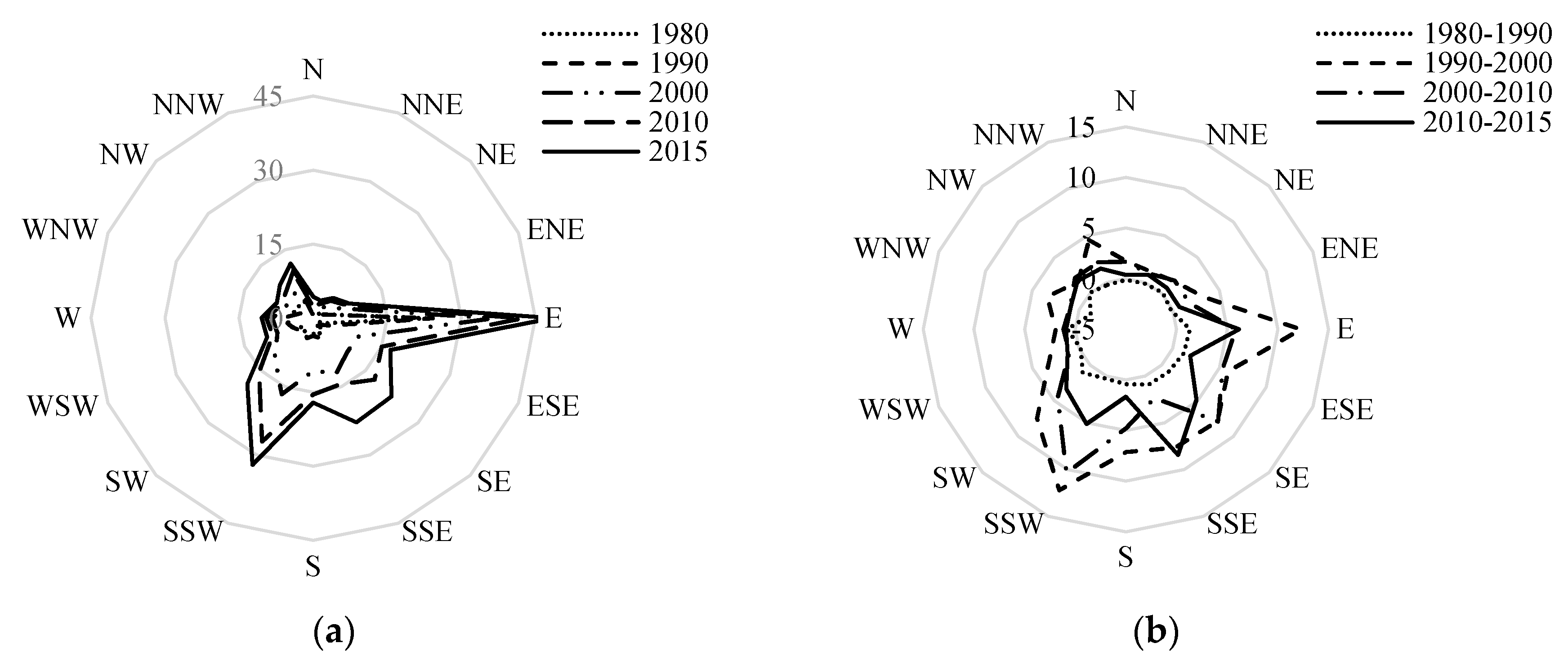
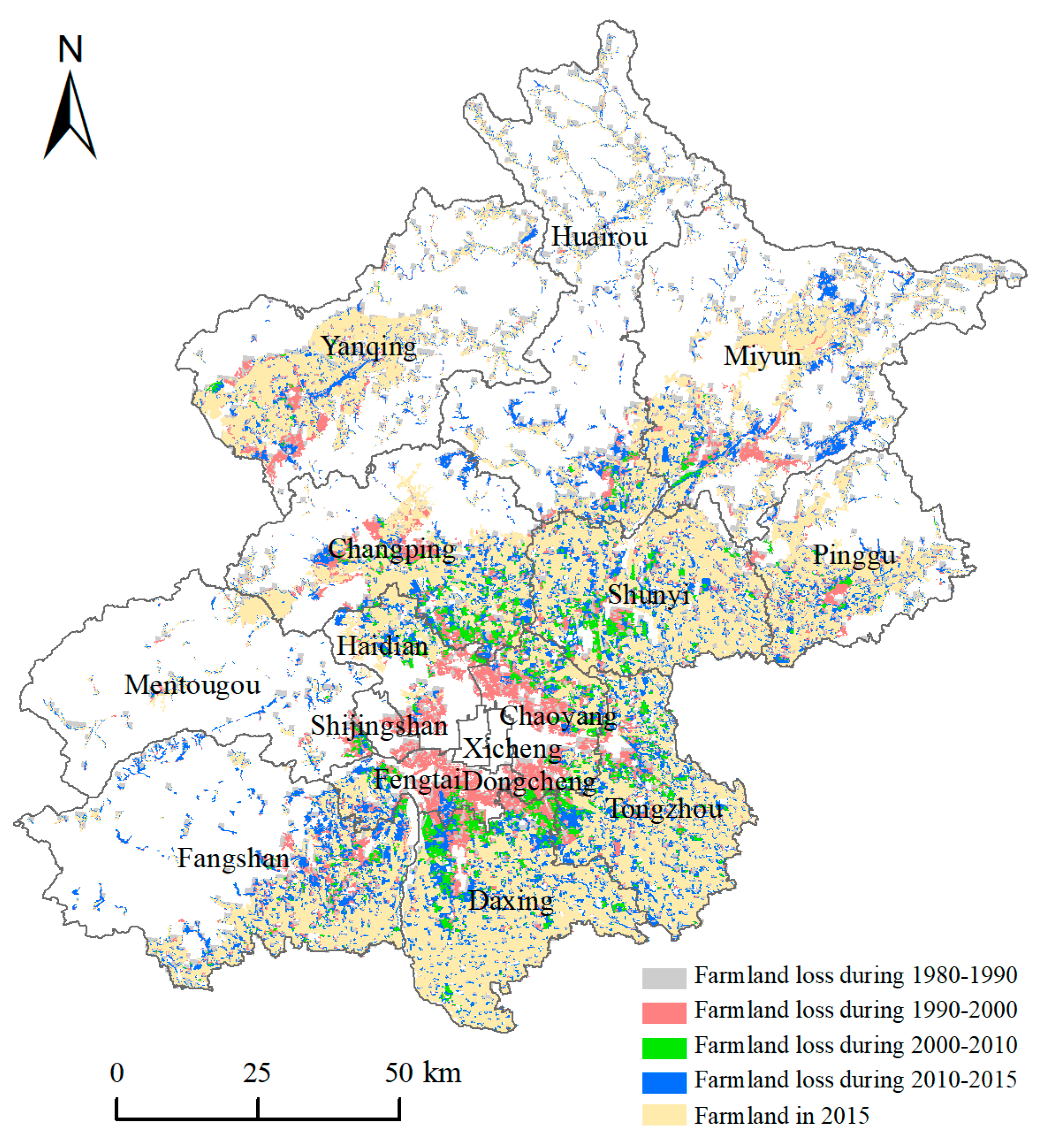
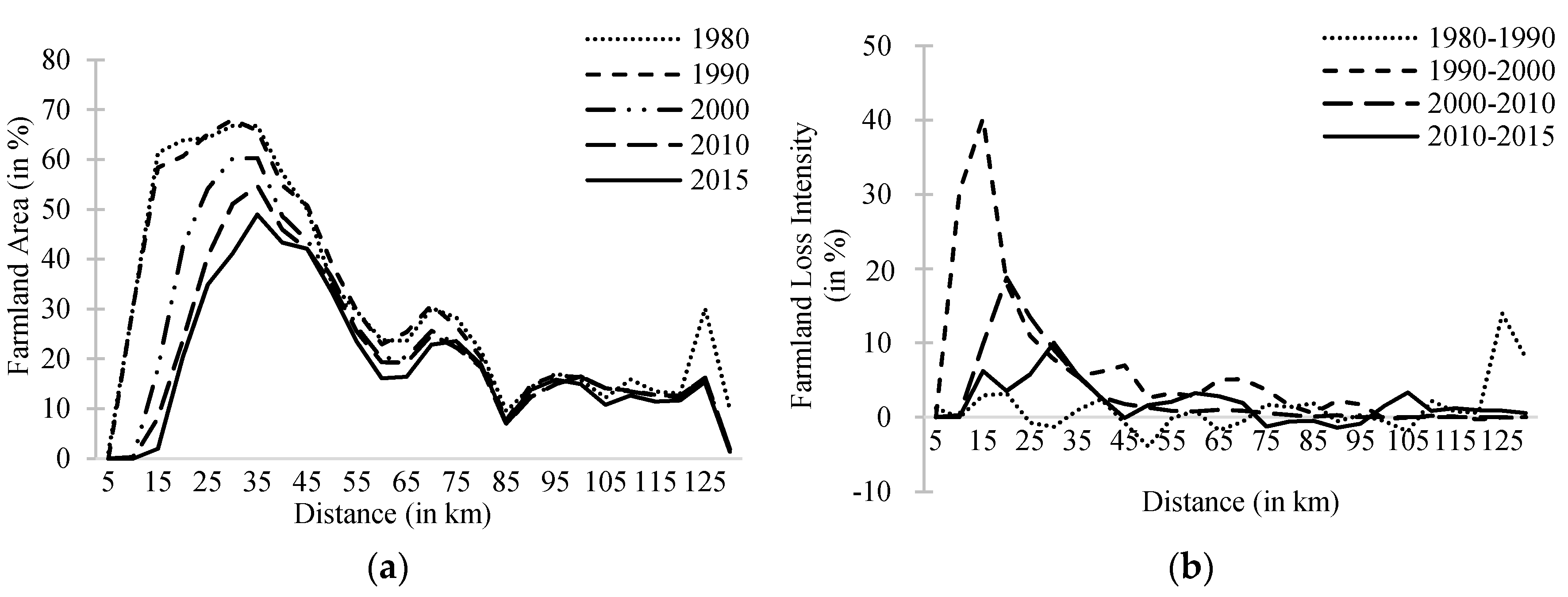
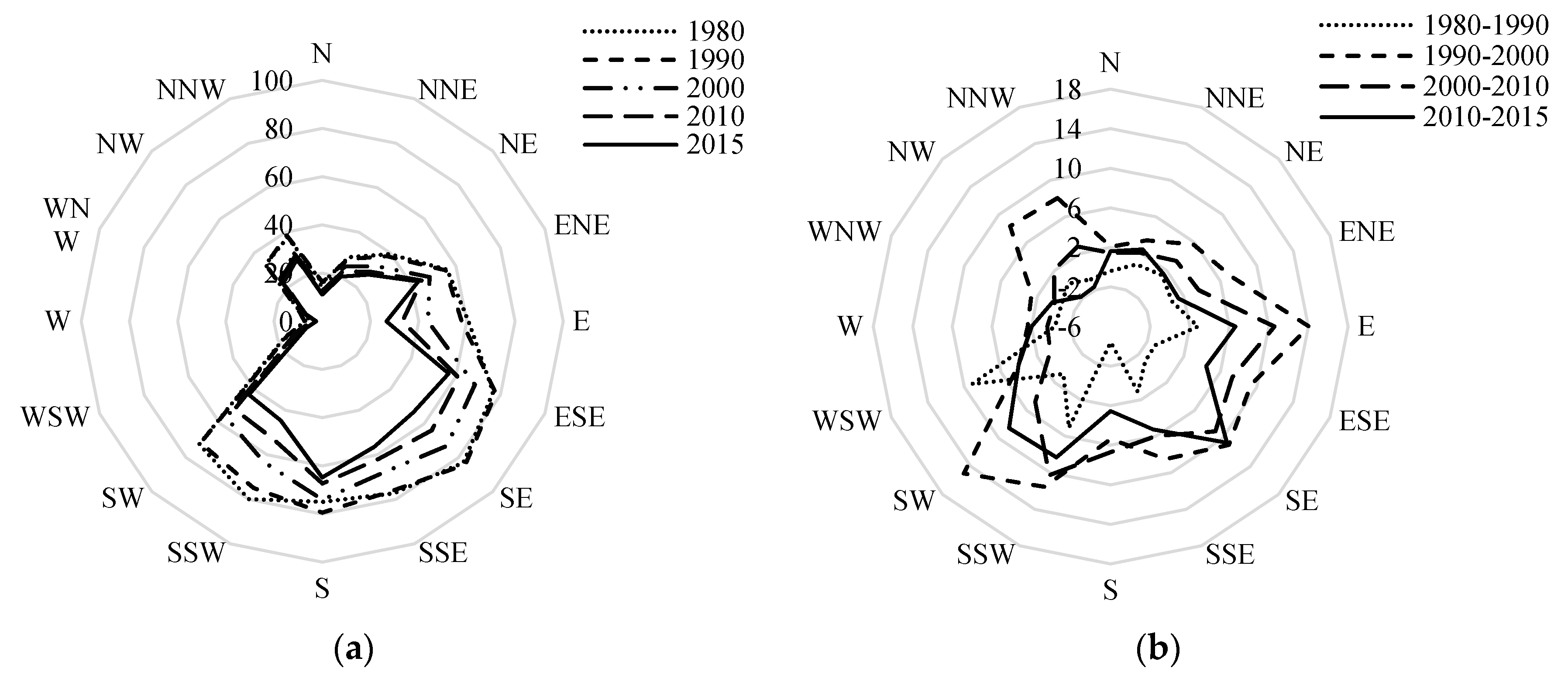
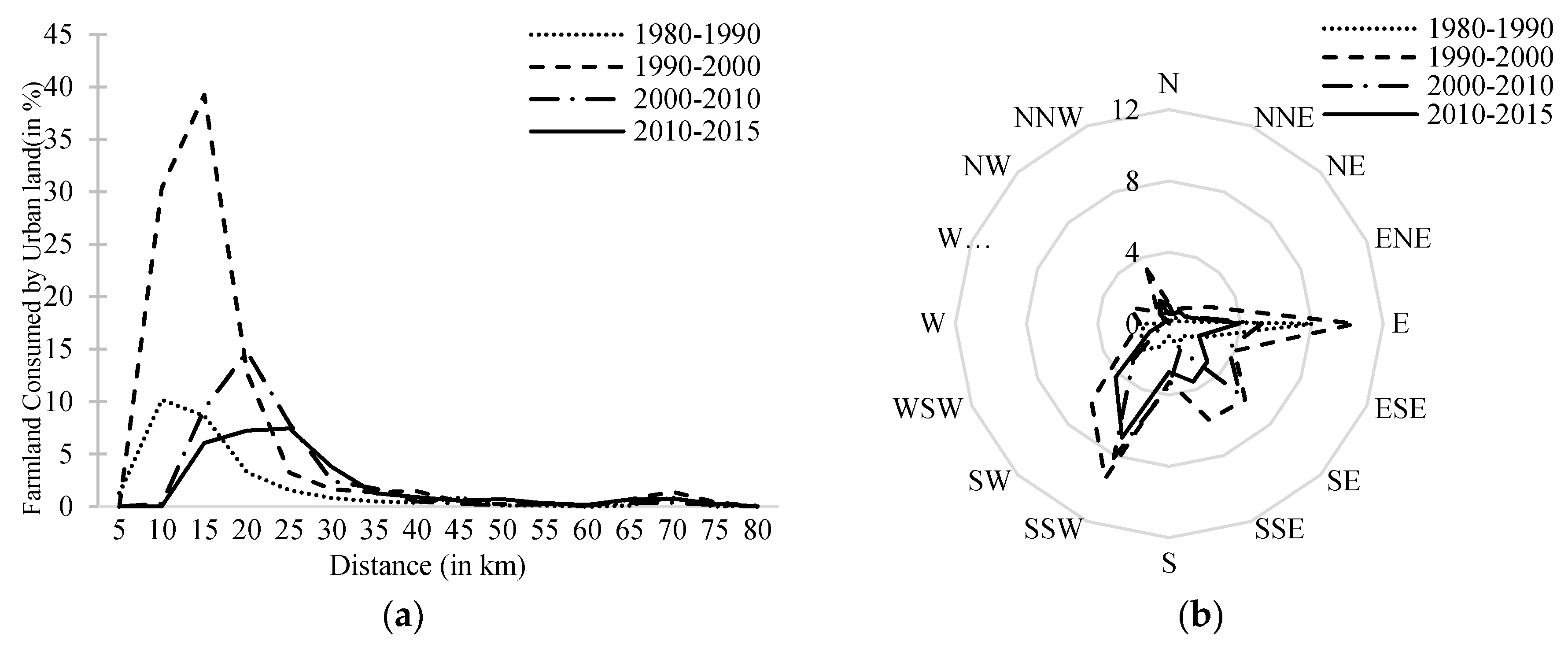


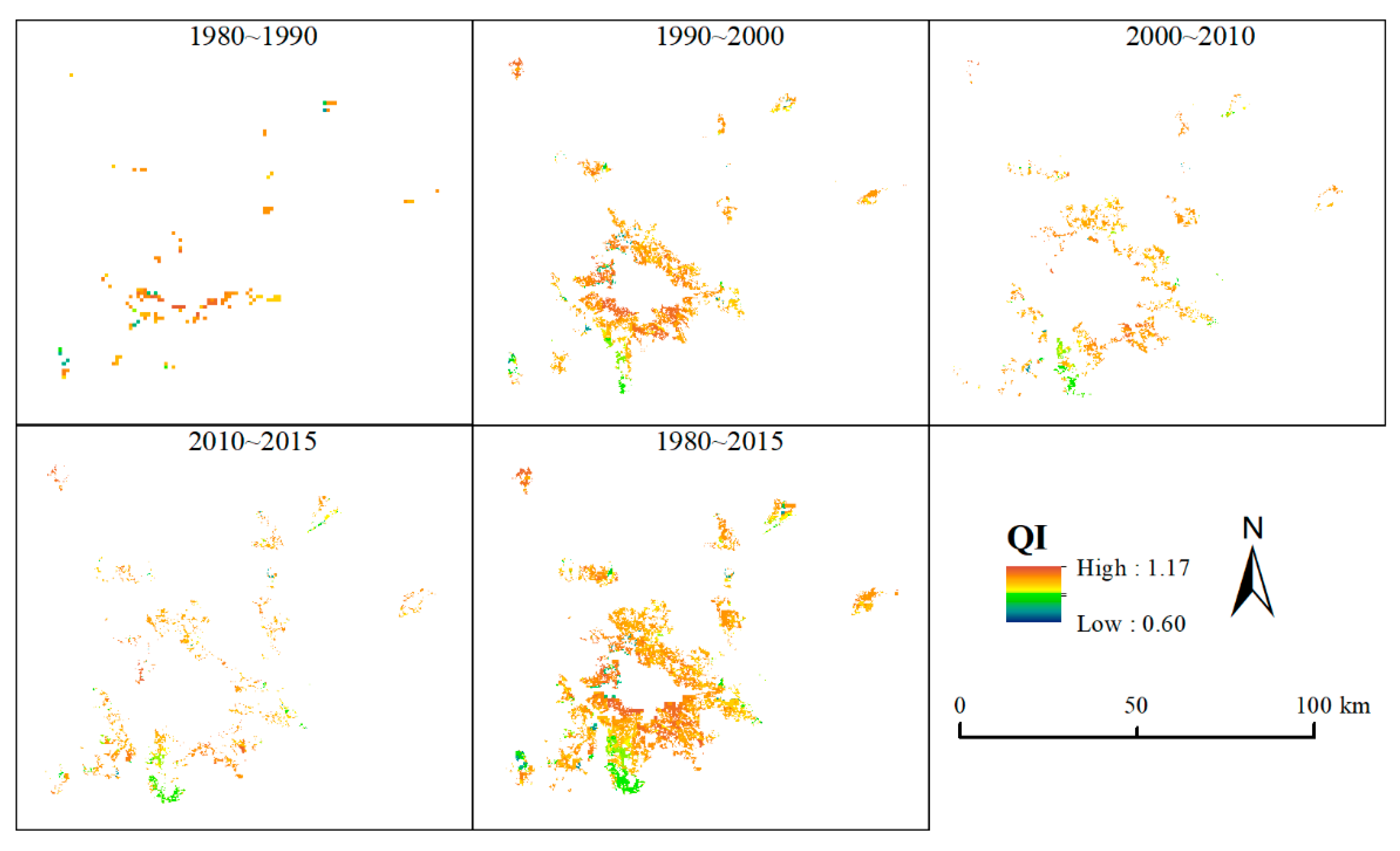
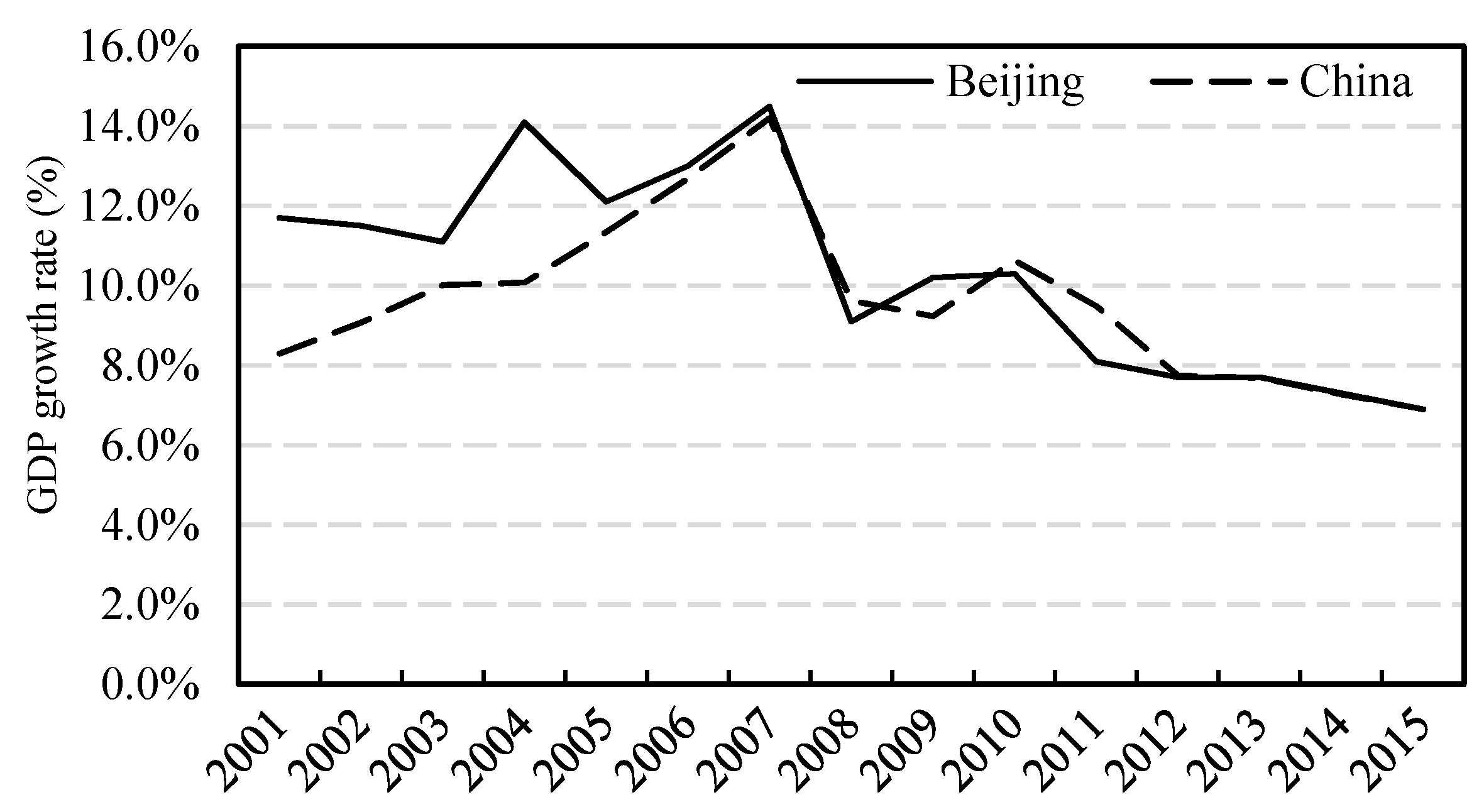
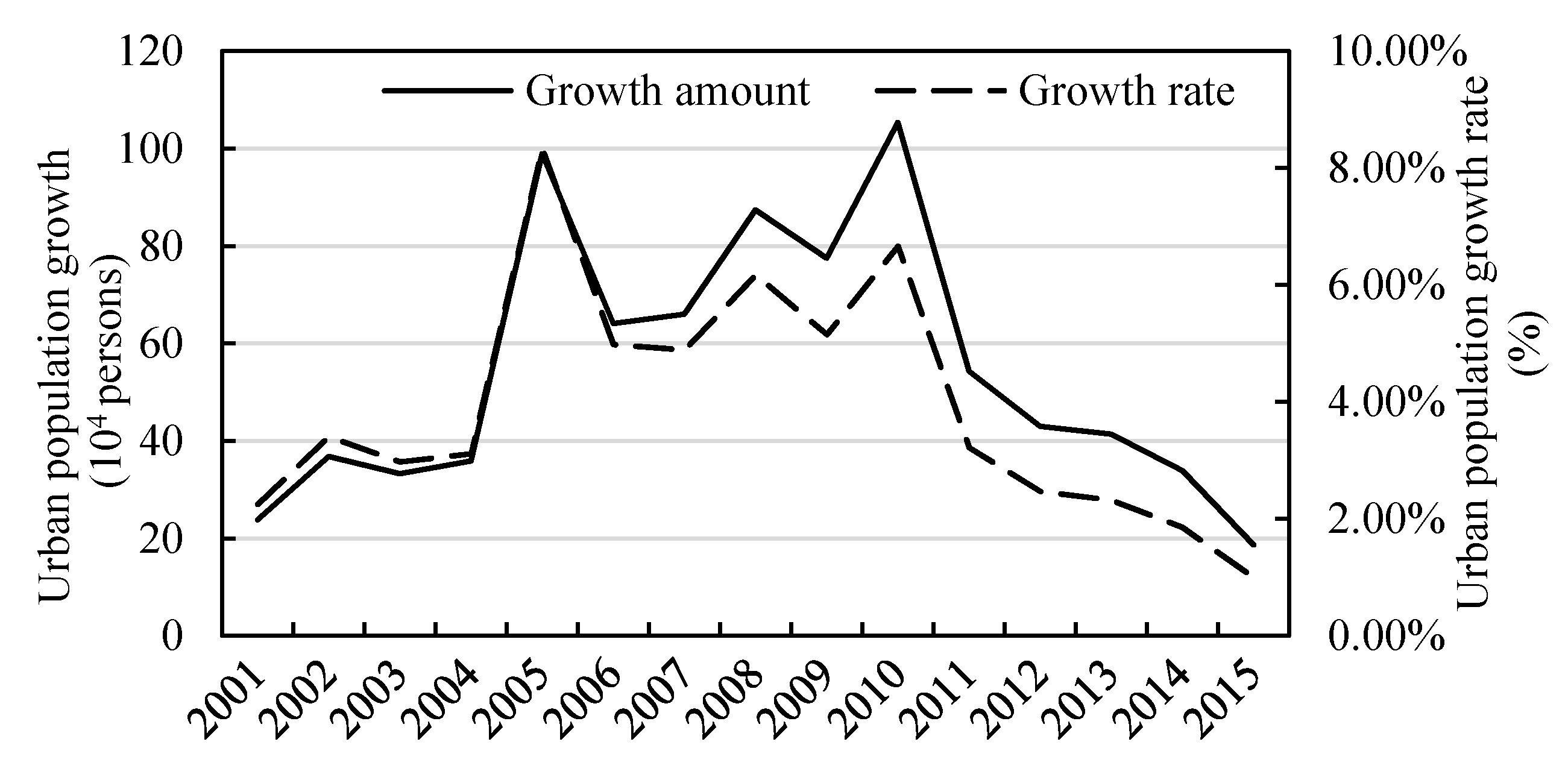
| Score | Soil Conditions | Topography | ||||
|---|---|---|---|---|---|---|
| Soil Texture | Soil Profile | Bulk Density (g/cm3) | Effective Soil Thickness (cm) | Soil Organic Matter (%) | Slope (◦) | |
| 100 | Heavy loam | loam/loam/loam, loam/clay/loam | 1–1.25 | ≥150 | ≥4.0 | ≤2 |
| 90 | Clay | loam/clay/clay, loam/sandy/loam, sandy/clay/clay | ≤1, 1.25–1.35 | 100–150 | 3.0–4.0 | 2–5 |
| 80 | Medium loam | clay/sandy/clay, clay/clay/clay | 2.0–3.0 | 5–8 | ||
| 70 | Light loam | gravel/clay/gravel | 1.35–1.45 | 60–100 | 1.0–2.0 | |
| 60 | Sandy loam | loam/sandy/sandy | 0.6–1 | 8–15 | ||
| 50 | Sandy soil | clay/sandy/sandy | 1.45–1.55 | ≤0.6 | ||
| 40 | Gravel soil | sandy/sandy/sandy, gravel/gravel/gravel | 30–60 | |||
| 30 | >1.55 | 15–25 | ||||
| 20 | ||||||
| 10 | ≥25 | |||||
| Weight | 0.15 | 0.12 | 0.1 | 0.2 | 0.13 | 0.3 |
| Year | Urban Land Area (km2) | Phases | Area of Expansion (km2/year) | Expansion Rate (%) | Expansion Intensity (%) |
|---|---|---|---|---|---|
| 1980 | 471 | 1980–1990 | 1.43 | 0.30 | 0.01 |
| 1990 | 485.29 | 1990–2000 | 54.97 | 11.33 | 0.33 |
| 2000 | 1035.01 | 2000–2010 | 37.17 | 3.59 | 0.23 |
| 2010 | 1406.74 | 2010–2015 | 47.16 | 3.35 | 0.29 |
| 2015 | 1642.52 | 1980–2015 | 33.47 | 7.11 | 0.20 |
| Year | Farmland Area (km2) | Phases | Area of Loss (km2/year) | Loss Rate (%) | Loss Intensity (%) |
|---|---|---|---|---|---|
| 1980 | 5903 | 1980–1990 | 4.76 | 0.08 | 0.03 |
| 1990 | 5855.41 | 1990–2000 | 93.42 | 1.60 | 0.57 |
| 2000 | 4921.18 | 2000–2010 | 48.03 | 0.98 | 0.29 |
| 2010 | 4440.89 | 2010–2015 | 73.94 | 1.66 | 0.45 |
| 2015 | 4071.20 | 1980–2015 | 52.34 | 0.89 | 0.32 |
| 1980–1990 | 1990–2000 | 2000–2010 | 2010–2015 | |
|---|---|---|---|---|
| CI | 0.75 | 0.72 | 0.63 | 0.57 |
| FI | 0.07 | 0.34 | 0.48 | 0.15 |
| Class | QI | 1980–1990 | 1990–2000 | 2000–2010 | 2010–2015 |
|---|---|---|---|---|---|
| Lower-quality | ≤0.9 | 8.73 | 5.47 | 6.98 | 11.18 |
| Medium-quality | 0.9–1.1 | 77.78 | 79.63 | 89.03 | 84.93 |
| Higher-quality | >1.1 | 13.49 | 14.90 | 3.99 | 3.89 |
© 2018 by the authors. Licensee MDPI, Basel, Switzerland. This article is an open access article distributed under the terms and conditions of the Creative Commons Attribution (CC BY) license (http://creativecommons.org/licenses/by/4.0/).
Share and Cite
Hu, Y.; Kong, X.; Zheng, J.; Sun, J.; Wang, L.; Min, M. Urban Expansion and Farmland Loss in Beijing during 1980–2015. Sustainability 2018, 10, 3927. https://doi.org/10.3390/su10113927
Hu Y, Kong X, Zheng J, Sun J, Wang L, Min M. Urban Expansion and Farmland Loss in Beijing during 1980–2015. Sustainability. 2018; 10(11):3927. https://doi.org/10.3390/su10113927
Chicago/Turabian StyleHu, Yingjie, Xiangbin Kong, Ji Zheng, Jin Sun, Linlin Wang, and Mingzhe Min. 2018. "Urban Expansion and Farmland Loss in Beijing during 1980–2015" Sustainability 10, no. 11: 3927. https://doi.org/10.3390/su10113927
APA StyleHu, Y., Kong, X., Zheng, J., Sun, J., Wang, L., & Min, M. (2018). Urban Expansion and Farmland Loss in Beijing during 1980–2015. Sustainability, 10(11), 3927. https://doi.org/10.3390/su10113927







